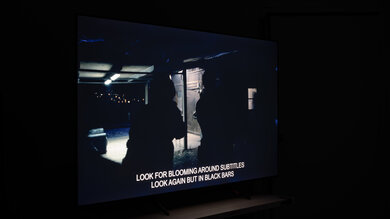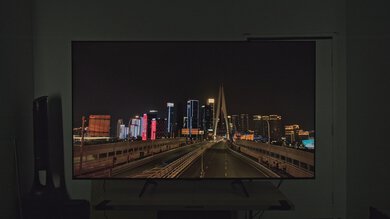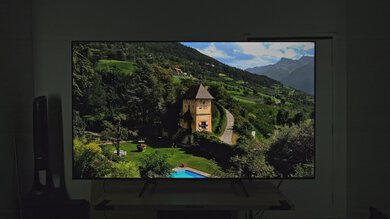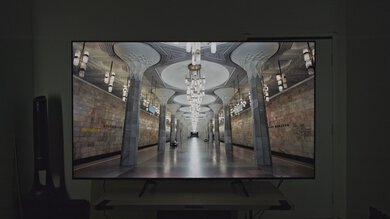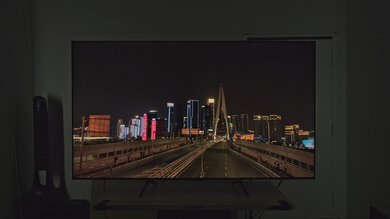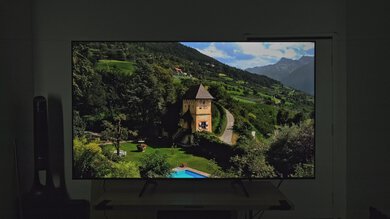The TCL S5/S551G is TCL's entry-level 4k model in 2024, replacing the TCL S4/S450G. It sits above lower-tier S Class models carried over from previous years, like the TCL S3/S35G, and below Q Class models, like the TCL Q6/Q651G QLED. Despite being part of the budget S Class, the S551G is the most advanced S Class model yet, offering features like VRR and Dolby Vision support. It can also pass through all common audio formats, including DTS. However, this is still a budget 60Hz model, so it lacks a local dimming feature to improve contrast and is limited to HDMI 2.0. It runs version 12 of Google TV and comes in sizes ranging from 43 to 85 inches.
Our Verdict
The TCL S551G is decent for mixed usage. It doesn't really stand out in any area, with decent brightness and an okay contrast ratio, so it's best suited to watching shows or playing games in moderately lit rooms. While it has good reflection handling, it doesn't get bright enough to really overcome glare in bright rooms. On the flip side, it's decent for dark room viewing, but it lacks a local dimming feature to improve contrast. It's a fine TV for gaming as well, with low input lag and a quick response time, although it doesn't support modern gaming features like 4k @ 120Hz or HDMI 2.1 bandwidth.
-
Good reflection handling.
-
Google TV offers a wide selection of apps.
-
Picture quality is just okay.
-
No local dimming to improve contrast.
The TCL S551G is okay for TV shows. It has good reflection handling, but it isn't the best option for very bright rooms due to its somewhat limited SDR brightness. It also has a narrow viewing angle, so it isn't well-suited to wider seating arrangements. Its picture processing is also lacking, with sub-par low-resolution upscaling and mediocre low-quality content smoothing that leaves some noticeable artifacts in low-bitrate content. Thankfully, the Google TV interface is smooth and easy to use, with plenty of apps to access a wide range of streaming content.
-
Good reflection handling.
-
Google TV offers a wide selection of apps.
-
Picture quality is just okay.
-
No local dimming to improve contrast.
-
Mediocre picture processing.
The TCL S5 is okay for sports. It's best suited to watching sports in a moderately lit room, as it doesn't get bright enough to overcome glare in very bright rooms, despite having good reflection handling. It has a mediocre viewing angle, too, so it isn't the best choice for watching with a big group. Its gray uniformity is decent, though there's some slight dirty screen effect that can be a bit distracting when watching sports like hockey with a large area of uniform color. On the upside, the TV has a good response time, so motion blur isn't an issue.
-
Good reflection handling.
-
Good response time.
-
Picture quality is just okay.
-
No local dimming to improve contrast.
-
Mediocre viewing angle.
The TCL S5 is good for video games. Although it doesn't have modern gaming features like HDMI 2.1 or 4k @ 120Hz, it's a solid option for gamers on a budget. It has a very low input lag and a good response time for a smooth, responsive gaming experience. It can also do 1080p and 1440p @ 120Hz and supports VRR to reduce screen tearing. That said, its picture quality is just okay, with limited contrast and brightness.
-
Good reflection handling.
-
Low input lag.
-
Good response time.
-
Picture quality is just okay.
-
No local dimming to improve contrast.
The TCL S551G is decent for watching movies in HDR. It supports all HDR formats, including Dolby Vision and HDR10+, which is nice. However, it simply doesn't get bright enough to make specular highlights pop. It also lacks a local dimming feature and has limited contrast, which, in combination with its sub-par brightness, means it doesn't create an impactful HDR viewing experience. Its picture processing is passable, but artifacts in low-bitrate streams aren't smoothed out very well. It also does a poor job of upscaling low-resolution content, so DVDs and low-resolution streams look muddy and lacking in detail.
-
Google TV offers a wide selection of apps.
-
Supports all HDR formats.
-
Picture quality is just okay.
-
No local dimming to improve contrast.
-
Poor HDR brightness.
-
Mediocre picture processing.
The TCL S5 is good for HDR gaming, mostly due to its gaming features. It doesn't support 4k @ 120Hz, since it's a 60Hz panel, but it can do 1080p and 1440p @ 120Hz with resolution halving. It also supports VRR to reduce screen tearing, and it has a very low input lag and good response time. However, it lacks a local dimming feature to improve its limited contrast, and it has poor HDR brightness, resulting in a lackluster HDR gaming experience.
-
Low input lag.
-
Good response time.
-
Supports all HDR formats.
-
Picture quality is just okay.
-
No local dimming to improve contrast.
-
Poor HDR brightness.
The TCL S5 is good for use as a PC monitor. It has a very low input lag in Game or PC Mode, resulting in a responsive desktop or gaming experience. It also has a good response time, so there's minimal motion blur, except with very fast cursor movements. It displays chroma 4:4:4 properly, but it uses a BGR subpixel layout, which impacts text clarity. Unfortunately, it doesn't have a very wide viewing angle, so the sides of the screen look washed out when sitting up close. Its SDR brightness is also just decent, so it can't overcome glare in very bright rooms.
-
Good reflection handling.
-
Low input lag.
-
Good response time.
-
Displays proper chroma 4:4:4.
-
Picture quality is just okay.
-
No local dimming to improve contrast.
-
BGR subpixel layout affects text clarity.
-
Mediocre viewing angle.
- 7.2 Mixed Usage
- 6.9 TV Shows
- 6.9 Sports
- 7.7 Video Games
- 7.2 HDR Movies
- 7.7 HDR Gaming
- 7.7 PC Monitor
Changelog
-
Updated Nov 28, 2024:
We mentioned the newly reviewed TCL Q5/Q550F QLED in the HDR Brightness section of this review.
-
Updated Nov 25, 2024:
Clarified that the included remote isn't backlit in the Remote section.
-
Updated Nov 12, 2024:
We mentioned the newly-reviewed TCL S3/S350G in the Contrast section of this review.
- Updated Oct 04, 2024: Review published.
- Updated Oct 01, 2024: Early access published.
Check Price
Differences Between Sizes And Variants
We bought and tested the 75-inch TCL S551G, which is also available in 43-, 50-, 55-, 65-, and 85-inch sizes. Only the 55-inch and larger sizes support TCL's Game Accelerator 120, so keep that in mind if you plan on using the TV for gaming. Other than that, our results are valid for the other sizes. There's also a massive 98-inch variant called the TCL S550G, but it features a different 120Hz panel, so the results here don't apply to that model.
| Size | US Model | Game Accelerator 120 |
|---|---|---|
| 43" | 43S551G | No |
| 50" | 50S551G | No |
| 55" | 55S551G | Yes |
| 65" | 65S551G | Yes |
| 75" | 75S551G | Yes |
| 85" | 85S551G | Yes |
Our unit was manufactured in April 2024, as shown on the label.
Popular TVs Comparisons
The TCL S5 is a fairly basic budget TV. While it lacks more advanced features like local dimming, it's cheap, comes in a wide range of sizes, and fits the bill for those who just want a simple 4k TV at a reasonable price. Its picture quality is nothing to write home about, especially for HDR content, but it's a good value option. It even includes some features found on pricier models, like VRR and Dolby Vision/HDR10+ support. If you're primarily looking for a budget gaming TV and are willing to trade in some contrast for a brighter TV with modern gaming features like HDMI 2.1 bandwidth and 4k @ 144Hz, you can get the Hisense QD7N QLED for just a bit more money.
For more options, check out our recommendations for the best budget TVs, the best TVs under $500, or the best LED TVs. To learn more about the testing process that informs our scores and recommendations, check out our article on how we test TVs.
The TCL S551G and the TCL Q651G are similar overall, but the Q6 is better, mostly due to it being the brighter model. The Q6 displays brighter highlights in HDR content, so it delivers a more impactful HDR experience, even though it's still not great. The Q6 also has the better SDR brightness, meaning it fights a bit more glare in a room with the lights on. Regarding color accuracy, the Q6 has better SDR pre-calibration results, so it doesn't require calibration if you care about accurate colors.
The TCL S551G is better than the TCL S4/S450G. While both have a somewhat limited contrast ratio and no local dimming, the S5 gets noticeably brighter, resulting in better overall picture quality, especially in brighter rooms. It also has a better viewing angle and wider color gamut, as well as offering more gaming features, like VRR and 1080p or 1440p @ 120Hz.
The TCL Q550G and the TCL S551G are similar TVs, but the Q550G is better overall. Thanks to its superior contrast, the Q550G displays deeper blacks, delivering a better dark room experience. Highlights pop out more in HDR content on the Q550G due to its higher HDR peak brightness, and its superior SDR brightness means it's more suitable for rooms with the lights on. Additionally, the Q550G has a slight edge with upscaling low-resolution content.
The TCL Q750G is far better than the TCL S551G. While the cheaper S551G has some advantages, namely slightly better accuracy, the Q750G is a higher-tier product, and it shows: far brighter, better contrast, more colorful, and improved image processing. It also has many more gaming features. Overall, unless you want to save some money, the Q750G is the pick.
The Hisense A7N and the TCL S551G are closely matched; in most cases, you should get the cheapest one you can find. The TCL has slightly better contrast, but in turn, the Hisense is a bit brighter, with a wider color gamut, but barely. The TCL's low-quality content smoothing is better than the Hisense's, but the latter's upscaling is noticeably better. The TCL is the better option for gaming due to its 120Hz support at 1440p and 1080p with a wide VRR range. Conversely, the Hisense is limited to 60Hz at all resolutions, with a narrow 48–60Hz VRR range.
The TCL S551G and the TCL Q550F are very similar, although the S551G uses Google TV while the Q550F uses Amazon's Fire TV OS. The Q550F has the better contrast and is the brighter of the two TVs, but the S551G has a wider viewing angle, making it better suited for wide seating arrangements. It also has the slightly better image processing overall.
The Hisense QD7N is better overall than the TCL S551G. While it's a bit pricier and has a worse contrast ratio, it gets noticeably brighter and offers more advanced gaming features, including HDMI 2.1 bandwidth for gaming up to 4k @ 144Hz.
The Hisense U6N and the TCL S551G are both entry-level TVs, but the Hisense is better overall thanks to its local dimming feature and significantly better contrast. That, combined with its higher peak brightness, provides much better picture quality and a more impactful HDR experience. That said, it has a worse viewing angle, so it's even less suitable for wide seating arrangements.
The TCL S551G and the Roku Select Series are both budget TVs that perform similarly overall, though the TCL has a slight edge. Aside from using different smart interfaces, they have similar contrast ratios and peak brightness. That said, the TCL has a wider color gamut and slightly better picture processing. The TCL also supports Dolby Vision and has more gaming features, like VRR.
Test Results
The TCL S551G looks very similar to the TCL Q6/Q651G QLED. It has thin bezels around the top and sides, with a slightly thicker brushed silver bezel on the bottom. Overall, it looks fairly premium for a budget model.
The TV uses simple V-shaped feet that you can set in either a narrow or wide configuration, depending on the size of your stand.
The wide configuration, pictured above, has a footprint of 50.4" x 13.5", while the narrow configuration has a footprint of 28.3" x 13.5". The screen sits about 3.7" above the table, which is enough clearance for most soundbars.
The back of the TV is made of plastic, with a grid-like pattern similar to other TCL models released in 2024. There's a recessed cutout on the left side for the inputs and a smaller recess on the right side for the power cable. The TV doesn't come with any cable management accessories.
The TCL S551G has better contrast than the cheaper TCL S3/S350G. It's good enough to display dark scenes well, but there's no local dimming feature, so blacks are raised in scenes with bright highlights.
This TV doesn't have a local dimming feature, so it can't adjust the backlight of individual zones to brighten up highlights without impacting the rest of the image. That means that there are no distracting flickers or brightness changes as bright highlights move across the screen.
The TV has disappointing HDR brightness. It simply isn't bright enough to make specular highlights pop. Combined with its unimpressive contrast, it makes for a lackluster HDR viewing experience. If you're looking for similar but brighter TV, consider the TCL Q5/Q550F QLED instead.
These measurements are after calibrating the HDR white point with the following settings:
- HDR Picture Mode: Movie
- Brightness: 100
- Contrast: 100
- Gamma: 2.2
- Micro Contrast: Off
- Color Temperature: Warm -5
- Dynamic Tone Mapping: Off
Results with 'Dynamic Tone Mapping' set to 'Detail Priority':
- Hallway Lights: 280 cd/m²
- Yellow Skyscraper: 206 cd/m²
- Landscape Pool: 109 cd/m²
Results with 'Dynamic Tone Mapping' set to 'Balance':
- Hallway Lights: 287 cd/m²
- Yellow Skyscraper: 208 cd/m²
- Landscape Pool: 135 cd/m²
Results with 'Dynamic Tone Mapping' set to 'Brightness Priority':
- Hallway Lights: 295 cd/m²
- Yellow Skyscraper: 212 cd/m²
- Landscape Pool: 156 cd/m²
The TV's HDR brightness isn't noticeably different when set to Game Mode.
These measurements are after calibrating the HDR white point with the following settings:
- HDR Picture Mode: Game
- Game Master: On
- Brightness: 100
- Contrast: 100
- Gamma: 2.2
- Micro Contrast: Off
- Color Temperature: Warm -5
- Dynamic Tone Mapping: Off
Results with 'Dynamic Tone Mapping' set to 'Detail Priority':
- Hallway Lights: 285 cd/m²
- Yellow Skyscraper: 209 cd/m²
- Landscape Pool: 122 cd/m²
Results with 'Dynamic Tone Mapping' set to 'Balance':
- Hallway Lights: 290 cd/m²
- Yellow Skyscraper: 212 cd/m²
- Landscape Pool: 136 cd/m²
Results with 'Dynamic Tone Mapping' set to 'Brightness Priority':
- Hallway Lights: 294 cd/m²
- Yellow Skyscraper: 213 cd/m²
- Landscape Pool: 156 cd/m²
The TCL S551G has fantastic PQ EOTF tracking. While blacks and near blacks are raised, everything else is displayed very close to its intended brightness in content mastered at all nit levels. There's a gradual roll-off at the TV's peak brightness to preserve some detail in very bright specular highlights.
The TV's SDR brightness is decent. It's suitable for moderately lit rooms but doesn't get bright enough to overcome glare in a very bright room.
These measurements are after calibration with the following settings:
- Picture Mode: Movie
- Brightness: 100
- Contrast: 99
- Black Level: 50
- Dynamic Contrast: Off
- Black Stretch: Off
- Dynamic Brightness: Off
- Micro Contrast: Off
- Gamma: 2.2
The TCL S551G has a wide color gamut. It covers most of the commonly used DCI-P3 color space, and colors are very accurate for the most part. Its coverage of the wider Rec. 2020 color space, on the other hand, is just okay, and more vibrant colors tend to be undersaturated.
The TV's color volume is decent. Most colors aren't displayed very brightly, and the TV struggles with dark saturated colors as a result of its unimpressive contrast.
The TCL S5 has mediocre pre-calibration accuracy. Colors aren't too off the mark, but less saturated colors tend to be more inaccurate. Its white balance is also very off, as most shades of gray and white have too much red in them. The TV's color temperature also falls a bit on the warmer side, but it's still quite close to our 6500K target. The gamma is also close to 2.2, but brighter scenes are too bright.
After calibration, the TV's accuracy is significantly improved. There are no longer any issues with white balance, and colors are even more on point. The color temperature and gamma are also right on target.
See our full calibration settings.
The TV has good reflection handling overall. Its semi-gloss screen does an especially good job of reducing the intensity of indirect reflections. However, direct reflections from light sources directly facing the screen are more distracting.
The TV's gradient handling is adequate, but there's noticeable banding in dark greens, reds, and blues, as well as darker grays. Banding is less apparent with lighter shades, however.
The TV does isn't very good at upscaling low-resolution content like DVDs or low-res streams. A lot of finer details are lost or hard to make out, including small hard-coded text.
Sharpness processing was calibrated with no over-sharpening for low-resolution content with the following settings:
- Sharpness: 20
The TV uses a BGR (Blue-Green-Red) subpixel layout instead of the traditional RGB layout. This doesn't cause any issues for video or gaming content, but it can be a problem for PC monitor use as it impacts text clarity, although not everyone will notice this.
The TV uses a KSF phosphor coating to produce red light and a quantum dot color converter to produce green light, as confirmed by the TV's spectral power distribution (SPD).
This TV uses pulse width modulation (PWM) to dim its backlight. It flickers at 150Hz, which is low enough to be noticeable by users who are sensitive to it, especially since it doesn't flicker in time with the TV's refresh rate. Unfortunately, there's flicker in every picture mode, but the TV is flicker-free when the brightness is set to 29 or above.
This TV doesn't have an optional backlight strobing feature, commonly known as black frame insertion (BFI), to help reduce persistence blur.
Due to the TV's response time, there's some minor stutter when watching movies or TV shows. It's most noticeable during slow panning shots.
With Nature Cinema enabled, the TV automatically removes 24p judder from all sources.
The TCL S5 supports all three types of variable refresh rate (VRR) technology to reduce screen tearing. It has a very narrow VRR range in 4k but has a much wider range in 1080p and 1440p @ 120Hz.
The TV's input lag is very low when set to Game Mode, ensuring a very responsive gaming experience.
The TV supports all common resolutions up to 4k @ 60Hz. It displays chroma 4:4:4 properly when set to PC or Game Mode.
Since it's limited to a 60Hz refresh rate, the TCL S5 can't take full advantage of the PS5, but it does support 1080p and 1440p @ 120Hz with resolution halving. It also has no issues with HDR games on the PS5 and supports VRR and Auto Low Latency Mode (ALLM) with 'Game Master' set to 'Auto,' so it'll automatically switch to Game Mode when it detects a console.
Likewise, the TV can't take full advantage of the Xbox Series S or X. As with the PS5, though, it can do 1080p and 1440p @ 120Hz, and it supports VRR and HDR, including Dolby Vision. It also supports ALLM with 'Game Master' set to 'Auto,' so you don't have to worry about manually switching to Game Mode for the lowest latency.
This TV is limited to HDMI 2.0 bandwidth on all three HDMI ports. It supports all HDR formats, including HDR10+ and Dolby Vision, so you won't have any compatibility issues. Unfortunately, its tuner is limited to ATSC 1.0, so you can't stream 4k content over the air.
This TV supports eARC for passthrough of high-quality, uncompressed audio formats via HDMI. It supports all major audio formats, so you don't have to worry about compatibility with external sources.
The built-in speakers on the TCL S5 don't sound especially accurate. They don't get very loud and can't produce that boomy bass that elevates cinematic content and action. Otherwise, dialogue and other middle frequencies are reasonably clear at moderate volume levels, but the sound profile becomes more imbalanced as it gets louder.
Distortion isn't bad overall, especially at moderate volumes. Once you get up to the TV's max volume, however, it becomes more noticeable.
The TV has a wide selection of apps, so it's easy to find your favorite content. You can also cast content from your phone to the TV or play videos directly from a USB stick.
The remote is similar to the remote that comes with last year's TCL S4/S470G. It has preset buttons for popular streaming services. You can also use the built-in microphone to switch inputs, change apps, search within apps, and ask for the weather and time. Unfortunately, you can't change the settings on the TV using the voice controls, and the remote isn't backlit.
Comments
TCL S551G: Main Discussion
Let us know why you want us to review the product here, or encourage others to vote for this product.
- 21010
Thanks for the reply. Unfortunately no luck. AppleTV 4k recognized the S551F as 4k HDR10+/DV compatible, but the FireTV OS crashed persistently. This was with a HDMI 2.1 cable and enabling 2.0 speeds on the TV. A massive flaw, as this TV is advertised as capable of HDR10+ and DV. Have returned and switched to a Hisense U7. Wow. Google TV OS is light years better, and the Hisense just looks better. If you’re considering buying this TV for a dorm room, it’s a good deal, but if you’d like to utilize those features like HDR10+ / DV, this is not the one.
I am extremely unsatisfied with the FireTV OS as well, in all regards. I will not use it for anything.
- 21010
On the FireTV version, while on the desired input: Press the “Gear” button on remote (top right below power button) Select “Picture” option. Scroll to the very bottom and select “Advanced Settings” Scroll to the very bottom and select “HDMI Input Mode” Change setting to “Mode 2 (2.0)” Hope this helps.
Thanks for the reply. Unfortunately no luck. AppleTV 4k recognized the S551F as 4k HDR10+/DV compatible, but the FireTV OS crashed persistently. This was with a HDMI 2.1 cable and enabling 2.0 speeds on the TV. A massive flaw, as this TV is advertised as capable of HDR10+ and DV. Have returned and switched to a Hisense U7. Wow. Google TV OS is light years better, and the Hisense just looks better. If you’re considering buying this TV for a dorm room, it’s a good deal, but if you’d like to utilize those features like HDR10+ / DV, this is not the one.
- 21010
Yeah that’s right, if your external player is doing the upscaling for you then you won’t have to worry about this. If you do plan on using an older device like a Wii, there are also external upscalers available that will do a much better job than the TV’s built-in processing.
Thanks for the reply Adam, sounds good! :)
- 21010
Can you explain how to do this? S551F, and anytime I try to play HDR or Dolby Vision content via AppleTV, it seems the FireTV OS just crashes. I imagine being locked to HDMI 1.4 would explain it, but I see no options regarding changing this.
On the FireTV version, while on the desired input: Press the “Gear” button on remote (top right below power button) Select “Picture” option. Scroll to the very bottom and select “Advanced Settings” Scroll to the very bottom and select “HDMI Input Mode” Change setting to “Mode 2 (2.0)”
Hope this helps.
Edited 3 months ago: spelling - 21010
So, I was considering this just as an extra, basic TV for an extra bedroom. Just looking for something cheap, so this would be fine enough. My main concern would just be the upscaling. My understanding is that this is actually referring to upscaling when the TV is doing it itself, correct? So if I hook up a DVD player or a Wii or something to the TV, it wouldn’t look great, but let’s say I hook up a newly released Switch 2, and play some 900p Switch games on it that the Console itself is upscaling to 4K. In that case, the Console is doing the upscaling, so it would be fine, right? If that’s the case, it’s not much of a worry, but otherwise could be a dealbreaker.
Yeah that’s right, if your external player is doing the upscaling for you then you won’t have to worry about this. If you do plan on using an older device like a Wii, there are also external upscalers available that will do a much better job than the TV’s built-in processing.
- 32120
For anyone trying to use this screen as a monitor, it will not output 4:4:4 chroma @60hz by default in PC mode, it is locked in 30hz 4:4:4 chroma or 60hz 4:2:0 chroma due to limiting itself to HDMI 1.4 under its auto-detection. You need to go into the settings and change the HDMI mode manually to HDMI 2.0. This is true for the S551F (FireTV), S551G (AndroidTV), and S555 (Roku) versions of this set. This may only be an issue with Nvidia GPUs but not confirmed. @rtings please update the inputs and PC Monitor section to reflect this necessity.
Can you explain how to do this? S551F, and anytime I try to play HDR or Dolby Vision content via AppleTV, it seems the FireTV OS just crashes. I imagine being locked to HDMI 1.4 would explain it, but I see no options regarding changing this.
- 21010
So, I was considering this just as an extra, basic TV for an extra bedroom. Just looking for something cheap, so this would be fine enough. My main concern would just be the upscaling. My understanding is that this is actually referring to upscaling when the TV is doing it itself, correct? So if I hook up a DVD player or a Wii or something to the TV, it wouldn’t look great, but let’s say I hook up a newly released Switch 2, and play some 900p Switch games on it that the Console itself is upscaling to 4K. In that case, the Console is doing the upscaling, so it would be fine, right? If that’s the case, it’s not much of a worry, but otherwise could be a dealbreaker.
Edited 3 months ago: Grammar - 32120
For anyone trying to use this screen as a monitor, it will not output 4:4:4 chroma @60hz by default in PC mode, it is locked in 30hz 4:4:4 chroma or 60hz 4:2:0 chroma due to limiting itself to HDMI 1.4 under its auto-detection.
You need to go into the settings and change the HDMI mode manually to HDMI 2.0. This is true for the S551F (FireTV), S551G (AndroidTV), and S555 (Roku) versions of this set.
This may only be an issue with Nvidia GPUs but not confirmed.
@rtings please update the inputs and PC Monitor section to reflect this necessity.










